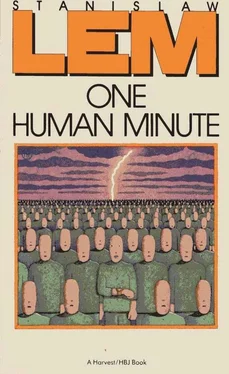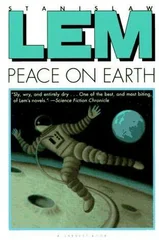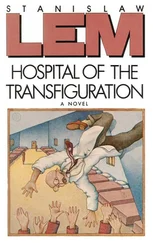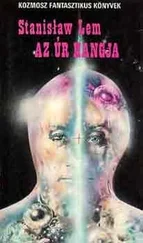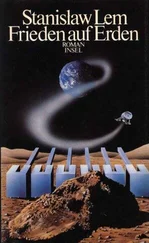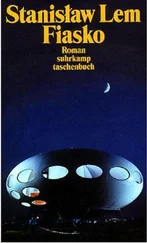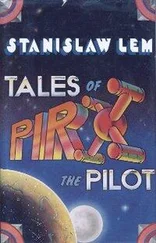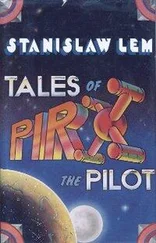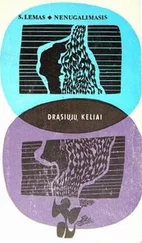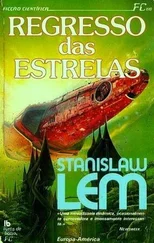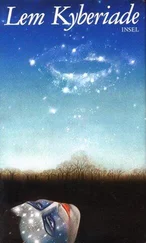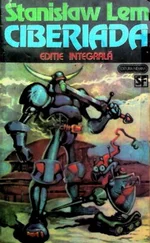The planetary catastrophe worked against the large animals not directly but indirectly, through the interruption of the food chain in the biosphere. When photosynthesis stopped, vegetation withered on a massive scale, and the large herbivorous reptiles of land, sea, and air could not find enough food. The predators who ate the herbivores perished for the same reason. A huge number of marine animals also died out, because in the oceans the biological carbon cycle proceeds much faster than on land, and because the surface layers of water cooled more quickly than the deeper layers. A few small reptile species did survive. But the small mammal survivors were numerous, and so, when the dust of the meteor settled and the atmosphere cleared and plant life revived, they began to differentiate, branching into many species, which after forty million years produced the line of primates from which Homo sapiens descended.
Thus the cause — indirect but undoubted — of rational man’s emergence was a cataclysm on the C-T boundary. For our subject, however — the military evolution of civilization — it is the consequences of this event, so long overlooked, that are important. The fact is that the ones who suffered least on the C-T boundary were the insects! Before the catastrophe there were about three-quarters of a million insect species; a short time afterward, there were still at least seven hundred thousand, and social insects like ants, termites, and bees survived the cataclysm practically unimpaired. This leads us to conclude that cataclysms are survived most easily and with the greatest probability by small or very small animals with an insectile anatomy and physiology.
Nor should one consider it an accident that insects are generally much less susceptible to the lethal effects of radioactivity than the so-called higher animals, the vertebrates. Paleontology speaks unequivocally. A catastrophe that unleashed the destructive force of a global atomic war killed every one of the large animals but did little damage to the insects and did not touch the bacteria. This shows that the greater the destructive action of an elemental force or technological weapon, the smaller must a system be in order to survive it unharmed. Thus the atomic bomb demanded the dispersal not only of whole armies but also of individual soldiers. General staffs considered dispersing their armies, but in the twentieth century the idea of reducing a soldier to the size of an ant or a wasp found no expression outside the pages of fantasy. A human being couldn’t be reduced or dispersed! In those days much thought was given to soldier-automatons — humanoid robots — a naive anthropomorphism. Yet heavy industry was already undergoing unhumanization, and the robots that replaced people on the assembly lines were not remotely humanoid. They were the enlargement of selected, functional parts of the human being: a computer “brain” with one huge steel hand assembling a car chassis, or a system with a hammer-fist, or with a laser-finger to weld the bodies. These devices worked like eyes and hands but did not look like eyes or hands. But large and heavy robots such as these could not be put on the battlefield, where they would immediately become the target of accurate, self-guided, intelligent missiles.
So it was not humanoid automata that formed the new armies but synthetic insects (synsects) — ceramic microcrustacea, titanium annelids, and flying pseudo-hymenoptera with nerve centers made of arsenic compounds and with stingers of heavy, fissionable elements. Most of this “nonliving micropersonnel” could, at the first warning of an atomic attack, dig deep into the ground and then crawl out after the explosion, maintaining combat functions even in an environment glowing with terrible radioactivity, because these soldiers were not only microscopic but nonbiological. The flying synsect combined plane, pilot, and missile in one miniature whole. But the operating unit was the microarmy, which possessed superior combat effectiveness only as a whole (just as a colony of bees was an independent, surviving unit while a single bee was nothing).
Because the battlefield was constantly exposed to atomic attack, which not only destroyed combat forces but also disrupted all communications between the various weapons systems (and also between the weapons and their command centers), there arose nonliving microarmies of many types. These were based on two opposing principles.
According to the first — the principle of autonomy — an army proceeded like a column of ants, or a wave of microbes, or a swarm of locusts. The last analogy is particularly apt. The locust, as we know, is simply a biological variety of the common grasshopper (not a separate species); even in clouds numbering hundreds of billions of specimens (still greater numbers have been observed from planes) it is not directly harmful to humans. [2] If one disregards the chief destructive result of such visitations — that is, the total loss of vegetation and cultivated crops.
Nevertheless, the sheer mass of a locust cloud can cause a train to derail, turn day into night, and paralyze all movement. (Even a tank, entering a cloud of locusts, will begin to slip as it crushes the insects into a pulp of ichor and grease and will bog down as in a quagmire.) The nonliving, synthetic “locust” was incomparably more lethal, since it was made that way by its designers. It possessed a preprogrammed autonomy, so that communication with a command center was unnecessary.
The pseudo-locust could be destroyed, of course, by an atomic attack, but this would have an effect like that of shooting at clouds with nuclear weapons: great holes would open, only to fill again with more cloud.
According to the second principle of the new military — telotropism — the microarmy was one giant flowing or flying aggregate of self-assembling elements. It started out dispersed, approaching its objective from many different directions, as strategy or tactics demanded, in order to concentrate into a preprogrammed whole on the battlefield. For this fighting material did not leave the factory in final shape, ready for use, like tanks or guns loaded on a railroad flatcar; the mechanisms were microproductive blocks designed to fuse together into a war machine at the designated place. For this reason, such armies were called “self-bonding."
The simplest example was a self-dispersing atomic weapon. Any missile launched from land, ship, or submarine could be destroyed from space by a satellite laser. But it was impossible to destroy gigantic clouds of microparticles carrying uranium or plutonium that merged into a critical mass only at the target. En route to the target, they were so dispersed as to be indistinguishable from fog or dust.
The competition between old and new weapons was brief: massive, armored equipment could not withstand the attacks of the microarmies. Just as germs invisibly invade an organism to kill it from within, so the nonliving, artificial microbes, following the tropisms built into them, penetrated the gun barrels, cartridge chambers, tank and plane engines. They corroded the metal catalytically, or, reaching the powder charges or fuel tanks, blew them up. What could even the bravest soldier, carrying grenades, a machine gun, a bazooka, or any other firearm, do against a nonliving, microscopic enemy? He would be like a doctor trying to fight the bacteria of cholera with a hammer or a revolver.
Amid a swarm of self-guided, programmed microarms, a man in uniform was as helpless as a Roman legionary with sword and shield against a hail of bullets. In the face of special types of biotropic microarms capable of destroying everything that lived, human beings had no choice but to abandon the battlefield, for they would be killed in seconds.
Читать дальше
